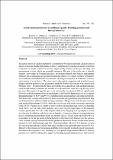Local chicken production in northern Uganda: Breeding practices and flock productivity
| dc.contributor.author | A Kayitesi, C Nakkazi, DR Kugonza, MW Okot, H Mulindwa, PM Mshenga, B Mugonola, NP Carsten, MA Olufemi, K Manjur, BA Odogwu, S Nkalubo, P Rubaihayo, E Zhou, J Walls, MP McHenry, D Doepel, JG Howieson, Neema John Mboya, L Tembo, G Asea, Paul T Gibson, P Okori, K Simango, D Lungu, Simon Wambui Mburu, Gilbert Koskey, Jacinta Malia Kimiti, Omwoyo Ombori, John Maingi, Ezekiel Mugendi Njeru, Ezekiel Chepkwony, M Korir, M Kipsat, J Ogembo Oyaro, P Nawiri, W Musila, JP Gweyi Onyango, Simon W Mburu, Jacinta M Kimiti, SB Nchore, JW Waceke, C Buttner, O Omwoyo, C Ulrichs, EW Mugi-Ngenga, MW Mucheru-Muna, JN Mugwe, FK Ngetich, FS Mairura, DN Mugendi, Jane Ndegi Mugambi, Okello Samuel Arum, Mumu Thomas Waithaka, M Okoti, WN Ekaya, JN Mugambi, EW Kairu, BO Danga, B Mochoge, J Mugwe, Z Getenga, P Tangut, R Karega, H Mulindi, T Thoruwa, S Okwach, Peter Okello Odhiambo, M Nabasirye, MM Tenywa, Y Bamutaze, CA Shisanya, MM Nsengiyunva | |
| dc.date.accessioned | 2020-08-13T12:59:59Z | |
| dc.date.available | 2020-08-13T12:59:59Z | |
| dc.date.issued | 2014 | |
| dc.identifier.uri | https://repository.maseno.ac.ke/handle/123456789/2088 | |
| dc.description.abstract | In Uganda, the local chicken population is estimated at 44 million and these chickens play an integral role in the smallholder farming systems. Contribution of local chicken in rural household economies is mainly limited by its low output mostly because of its poor breeding and management system, which are generally unknown. The aim of the study was to identify farmers’ knowledge on breeding practices, incubation methods and disease management strategies for local chicken in Gulu and Kiryandongo districts of Uganda. A total of 120 farmers were randomly selected from the two districts. The sample comprised of 60 farmers from two sub-counties of each district. The study used a descriptive, purposive and stratified survey design with both qualitative and quantitative methods of data collection and was carried out in February 2013. Results from the study showed that local chicken in Gulu and Kiryandongo reach sexual maturity almost at six months for cocks and hens, with three egg laying cycles per year. The number of eggs laid per cycle between the two districts differed significantly (P< 0.01) as did the number of chicks hatched per cycle (P< 0.05). Breeding stock was acquired through purchases by 88.5% and 93.3% of all respondents in Kiryandongo and Gulu respectively. All farmers rely on natural incubation by hens as a mode of egg hatching in both districts. Egg incubation facilities differed widely among respondents. The grass nest was the most common type used in Kiryandongo (28.3%), while the use of grass with sand was mostly reported in Gulu (38.3%). Farmers use a variety of criteria when selecting hens and cocks for a … | en_US |
| dc.publisher | RUFORUM | en_US |
| dc.title | Local chicken production in northern Uganda: Breeding practices and flock productivity | en_US |
| dc.type | Article | en_US |

